What is the true cost of an iPhone?
There are over 257 million smartphone users in the United States, with more than 60% of the population using a smartphone. Since its launch in 2007, Apple’s iPhone has grown considerably in popularity, with a 2017 study showing there are almost 86 million iPhone users in the US.
Over the last 11 years, we’ve seen the iPhone continue to innovate the smartphone space – but it is costing us more and more every year for the latest cell phone.
So, how much do we really spend on iPhones over the course of a lifetime? We looked into the cost of an iPhone if you bought your first one at 18, and upgraded right through until you turned 81.

iPhone
Average cost of an iPhone
If you were to buy an iPhone outright – paying the full cost upfront – the average price of an iPhone is $758. Over a 24 month contract period, on average you would be paying $2,736 for the cell phone and the airtime plan. Each September, the latest range of iPhones are unveiled and released.
We estimate that the price of an iPhone rises by $81 with each new flagship. If the cost of a new phone keeps rising steadily like this, in 60 years’ time we’ll be paying around $6,309 for the latest iPhone.
With the $1,000 barrier now well and truly broken, this may not be a huge surprise.
However, these seemingly small increases soon add up. If you were to buy a new iPhone every year, you would end up paying a total of $103,000 in your lifetime.
Here’s how much the latest iPhone will cost over the next six decades, if the price continues rising in the same way:
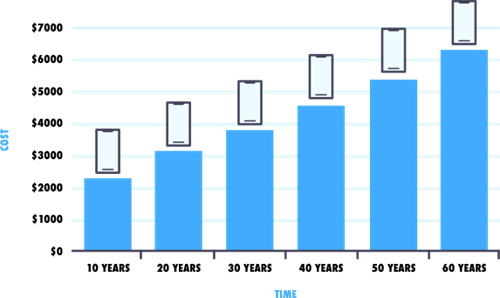
Graph showing the cost of an iPhone
The short term cost might not be considered when you’re upgrading your cell phone – but for the same amount of money, you could have bought a house, depending on the state, or two top-of-the-range Harley-Davidson bikes.
In terms of more luxurious items, you could have bought yourself a jet pack, travelled the world or even bought your own private island!

Plane
Rising Costs
With every new iPhone, we see a more advanced device with incredible features, awesome battery life and an improved camera. The next level of technology comes at a price – almost $1,500 for the top-end iPhone XS Max.
In the last decade, the cost of a brand new iPhone has increased by 114%. The average hourly wage hasn’t increased as quickly – it’s gone up by 25% from $20.96 in 2008 to $26.99 in 2018.
To buy the latest iPhone XS, the average person would have to work for 53 hours. This is a 61% increase compared to 2008 when the average person would have to work for 28 hours to buy the latest iPhone. For those earning the minimum wage of $7.25 an hour, they would need to work an incredible 199 hours to buy the newest iPhone. Fast forward to 60 years’ time – if the minimum wage increases at a similar rate...
...the average person would have to work for a staggering 306 hours to afford the $6,309 iPhone!
Here is what the average person will earn per hour over the next 60 years, based upon recent increases:
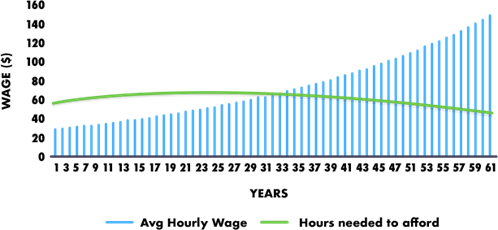
Graph showing hourly earnings
How can I reduce the cost of a new iPhone?
There are a few things you can do to make sure you’re not paying an absolute fortune for a new iPhone.
Sell your Phone
You can recoup some of the cost of your last phone when you trade it in or sell it privately. There are plenty of ways to sell iPhone handsets; you can use a trusted name like Decluttr to buy your phone from you to then refurbish it.
You can use eBay or Facebook Marketplace to list your phone but you should be aware that there are people who will waste your time. Marketplaces aren’t always safe either – you have no idea who you’re going to meet, or whether the item is legitimate. Using a name you can trust like Decluttr, you know how much you’ll make for your iPhone trade in before you send off your phone and your sale is guaranteed.

Laptop with Decluttr on it
Depending on the age, condition and storage space your phone has, you can make a decent wedge of money by selling your iPhone to help buy your new iPhone.

Decluttr Store
Buy Refurbished
If having the latest handset on the day of release isn’t super important to you, you could buy a refurbished device and literally save yourself hundreds of dollars.
The phone will work as you’d expect it to and it may not even have any marks to show it’s been used, depending on its condition.
Reduce your usage
When it comes to upgrading, you can save some money by buying the smallest storage option (which will most likely be 64GB) as well as reducing the data you sign up for.
For example, if you pay for 20GB of data a month but you aren’t even close to using it all, make some cuts on this to 10GB or 12GB to save a little each month. It’ll make a difference in the long run.

Storage

Upgrade
Break the cycle
The less you upgrade, the less you’ll have to pay when you do. However, don’t just let your contract overrun the 24 month period because you’ll end up paying way more than you should.
It’s important to know when your contract ends so you can either understand what your options are, with either your current network provider or a competitor. You could keep the cell phone you currently have, and just pay for an airtime plan that could cost you much less a month. Look around for the best SIM only deal.
You should understand how much data, minutes and texts you’re using right now and whether that is enough for you.
How is the environment affected?
Smartphone usage has a huge effect on the environment, from the production of the device, through to usage and finally to how it is disposed of.
We’re creatures of habit, so we have got used to upgrading our cell phones every two or three years – whether the phone is in working order or not. This cycle means that smartphones have become disposable but it’s crucial that we don’t simply throw our phones away because of their intrinsic materials.
Mining metals like gold (AU), silver (AG), platinum (PT) and palladium (PD) has a profound effect on the earth. The building of a smartphone represents up to 95% of the device’s total CO2 emissions for two years.
World Health Even when we’re done with our iPhones, simply chucking them away means these precious metals aren’t being reused and other chemicals tucked inside your little iPhone can cause pollution of air, soil and even drinking water.
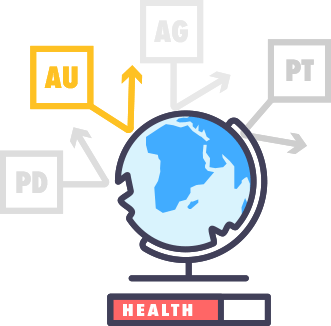
World Health
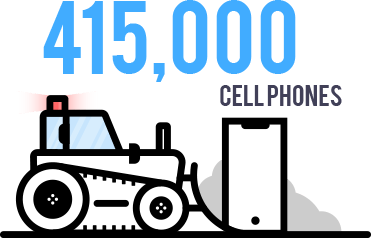
Landfill
More than 415,000 cell phones enter landfills and incinerators every day in the United States. Plus, as much as $55 billion is lost annually from squandered resources such as gold.
As trends shift, we’re seeing larger phones coming on to the market with supersized screens and plenty of power inside. The carbon footprint of a larger device is more than the smaller phones we used to use. Despite the options available like Decluttr to recycle our old phones, less than 1% are being recycled. It’s not just the iPhone itself either.
It’s the data centres we use that bump up the CO2 emissions from smartphone usage too. By 2020, 45% of ICT emissions will be accountable by data centres and servers. ICT represented just 1% of the carbon footprint in 2007 but by 2040, it’s expected to be at 14%.

Carbon footprint
As many as 84% of American households contain at least one smartphone, and a third have three or more smartphones. The average US household is missing out on $264 by holding on to their unwanted tech, rather than recycling with the likes of Decluttr.
Across America, that amounts to over $33 billion worth of unused tech.
What about refurbished phones?
There are plenty of reasons why you’d choose to buy a refurbished phone over a brand new one. One of the biggest factors to take into account is that refurbished devices are much cheaper. We crunched a few numbers to explain.
A brand new iPhone XS Max with 256GB storage option will cost you $1,249 direct from Apple. However, if you were to buy the same iPhone through Decluttr, the refurbished version would cost you $809.99.
If you would rather not invest in the latest iPhone, buying direct from Apple leaves your options for a cell phone pretty limited. Apple no longer manufacture the iPhone X or any iPhone older than the iPhone 7. To get your hands on an iPhone 6s, for example, would mean buying second hand or refurbished. An iPhone 6s with 128GB of memory from Decluttr in Good condition is less than $165!
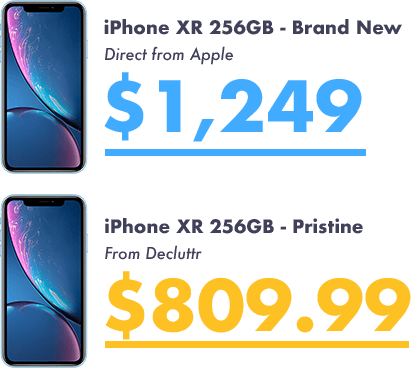
Refurbished phone comparison
Reusing the devices which already exist and refurbishing them to the best possible condition extends their life cycle – putting less pressure on the environment as we wouldn’t have to mine materials as often. The smaller devices emit fewer CO2 emissions, too.
One small change is important for our environment in the long run.




